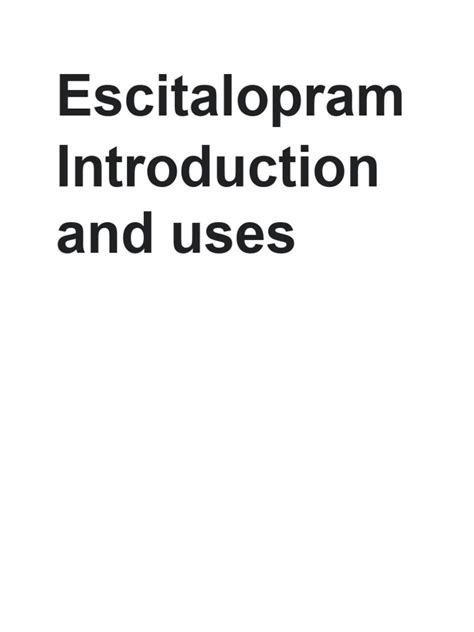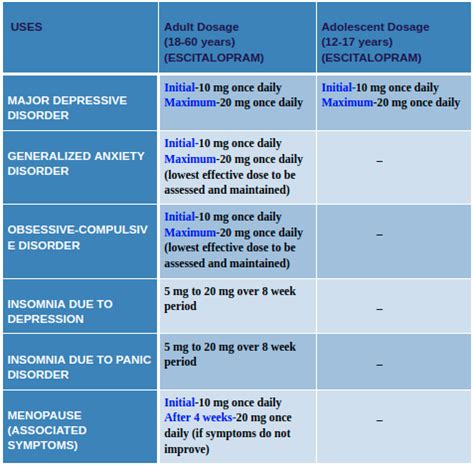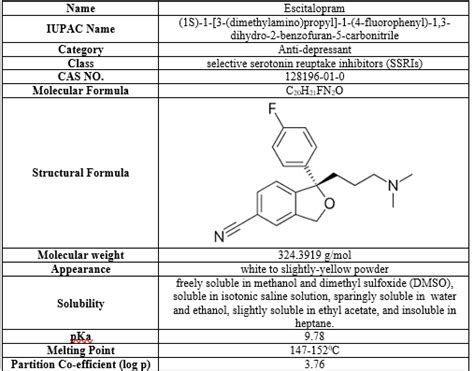Intro
Discover key facts about Escitalopram 10mg, including its uses, benefits, and potential side effects, to better understand this antidepressant medication and its role in treating anxiety and depression disorders.
Escitalopram, commonly known by its brand name Lexapro, is a medication primarily used to treat depression and generalized anxiety disorder. It belongs to a class of drugs called selective serotonin reuptake inhibitors (SSRIs), which work by increasing the levels of serotonin in the brain. Here are some key points to consider about Escitalopram 10mg:
The importance of understanding Escitalopram 10mg cannot be overstated, especially for individuals who are considering this medication as part of their treatment plan. With its widespread use, it's crucial to delve into the specifics of how it works, its benefits, potential side effects, and how it compares to other treatments. This knowledge empowers patients to make informed decisions about their mental health care. Moreover, the versatility of Escitalopram in addressing various mental health conditions makes it a significant topic of discussion in the medical community.
Escitalopram has been shown to be effective in managing symptoms of depression and anxiety, offering a relief that significantly improves the quality of life for many individuals. Its effectiveness, combined with a relatively favorable side effect profile compared to older antidepressants, makes it a commonly prescribed medication. However, like all medications, it's essential to understand its mechanism, potential interactions, and the importance of adherence to the prescribed dosage to ensure maximum benefit while minimizing risks.
As we explore the topic of Escitalopram 10mg further, it becomes clear that there's a wealth of information available, ranging from clinical trials data to patient testimonials. This medication has been extensively studied, and its impact on mental health treatment has been significant. By examining the details of Escitalopram, including its dosage, administration, and the conditions it treats, we can better appreciate the role it plays in modern psychiatry and its potential benefits for those struggling with mental health issues.
Introduction to Escitalopram

Escitalopram is a selective serotonin reuptake inhibitor (SSRI) that is used in the treatment of major depressive disorder (MDD) and generalized anxiety disorder (GAD). It works by increasing the amount of serotonin in the brain, which helps to improve mood and reduce anxiety. The medication is available in tablet form and is typically taken once daily, with or without food.
How Escitalopram Works
The mechanism of action of Escitalopram involves the inhibition of the reuptake of serotonin by the presynaptic neuron after it has been released into the synaptic cleft. This leads to an increase in the level of serotonin available for binding to the postsynaptic receptor, which is thought to contribute to its antidepressant and anxiolytic effects.Benefits of Escitalopram 10mg

The benefits of Escitalopram 10mg are numerous and well-documented. Some of the key advantages include:
- Effective in Treating Depression and Anxiety: Escitalopram has been shown to be effective in reducing symptoms of depression and anxiety in clinical trials.
- Relatively Favorable Side Effect Profile: Compared to some other antidepressants, Escitalopram is often associated with fewer side effects, although it's not side effect-free.
- Convenient Dosage: The medication is typically taken once daily, which can improve adherence for many patients.
Potential Side Effects
While Escitalopram is generally well-tolerated, it can cause side effects in some individuals. Common side effects include nausea, headache, and insomnia. More serious but less common side effects can include increased risk of suicidal thoughts, especially in young adults, and serotonin syndrome, a potentially life-threatening condition resulting from excessive levels of serotonin in the body.Dosage and Administration

The recommended dosage of Escitalopram for treating depression is 10mg once daily. For generalized anxiety disorder, the starting dose is also 10mg once daily. The dose may be increased to 20mg once daily after a minimum of one week based on clinical response and tolerability. It's crucial to follow the prescribed dosage and not to stop taking the medication without consulting a healthcare provider, as this can lead to withdrawal symptoms.
Interactions and Contraindications
Escitalopram can interact with other medications, including but not limited to, other SSRIs, monoamine oxidase inhibitors (MAOIs), and certain anti-inflammatory drugs. It's essential to inform your healthcare provider about all the medications you are taking before starting Escitalopram. Additionally, Escitalopram is contraindicated in patients with a hypersensitivity to escitalopram or citalopram, and it should be used with caution in patients with certain medical conditions, such as hepatic impairment.Comparing Escitalopram to Other Treatments

When comparing Escitalopram to other treatments for depression and anxiety, several factors come into play, including efficacy, side effect profile, cost, and patient preferences. Escitalopram is often compared to other SSRIs, such as sertraline (Zoloft) and fluoxetine (Prozac), as well as to serotonin-norepinephrine reuptake inhibitors (SNRIs) like venlafaxine (Effexor). The choice of medication depends on individual patient factors and should be made under the guidance of a healthcare provider.
Long-Term Use and Withdrawal
Long-term use of Escitalopram is common, and it can be effective for managing chronic conditions. However, stopping the medication abruptly can lead to withdrawal symptoms, which can include dizziness, headache, and irritability. It's recommended to taper off the medication gradually under the supervision of a healthcare provider to minimize these symptoms.Conclusion and Future Directions

In conclusion, Escitalopram 10mg is a valuable treatment option for individuals suffering from depression and generalized anxiety disorder. Its effectiveness, combined with a relatively favorable side effect profile, makes it a popular choice among healthcare providers. As research continues to uncover the complexities of mental health conditions, the role of medications like Escitalopram will evolve, offering hope for improved treatments and better patient outcomes.
Final Thoughts
For those considering Escitalopram as part of their treatment plan, it's essential to maintain open communication with their healthcare provider, discussing any concerns, side effects, or questions they may have. By working together, patients and healthcare providers can make informed decisions that lead to the best possible outcomes.We invite you to share your thoughts and experiences with Escitalopram 10mg in the comments below. Your insights can help others who are navigating similar challenges and can contribute to a broader understanding of this important medication. Additionally, if you found this article informative, please consider sharing it with others who might benefit from this information.
What is Escitalopram used for?
+Escitalopram is primarily used to treat major depressive disorder (MDD) and generalized anxiety disorder (GAD).
How long does it take for Escitalopram to start working?
+It can take several weeks, typically 4-6 weeks, for the full effects of Escitalopram to be noticeable.
Can I stop taking Escitalopram at any time?
+No, it's recommended to taper off Escitalopram gradually under the supervision of a healthcare provider to minimize withdrawal symptoms.
